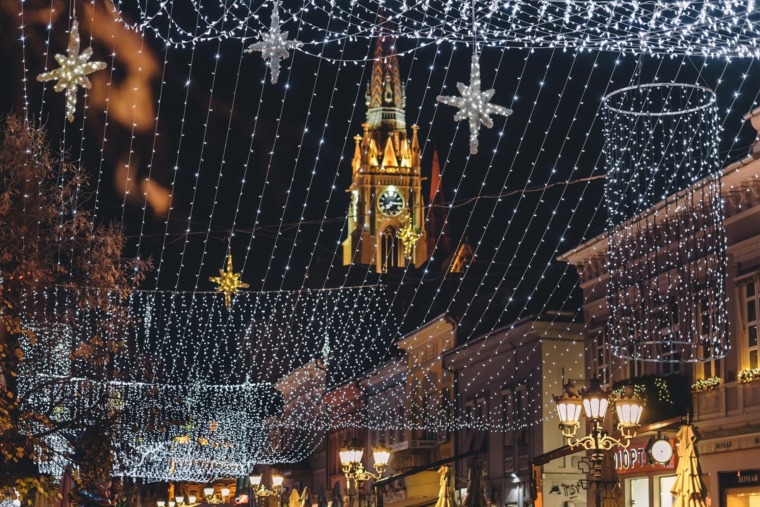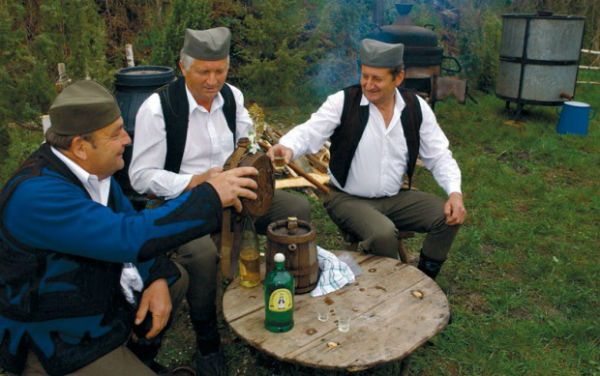

While drinking it people laugh, cry, rejoice, mourn, eat and sometimes even begin their day. It is present on every Serbian feast, made in cauldrons of “old masters“, in Serbia slivovitza is used for making toasts. It is a strong alcoholic drink that has unique smell and taste, it is served in a special shot glass called “čokanjčić“. Serbia is famous for the quality of its slivovitza, so don’t even think about leaving the country before trying one.
“Čačanska lepotica“ (The beauty of Čačak), “Stenley“, “Čačanska rana“ (Čačanska early), “Požegača“ (plum from Požega) and “Crvena ranka“ are the most common sorts of plums from which slivovitza is made in Serbia. The tastes may differ, but the best and most sought-after slivovitza is made form “Požegača“ and “Crvena ranka“. It can be served on feasts, in pubs or restaurants and people in Serbia sometimes use it as medicine (Inspired by Samuel Johnson’s quote “Claret is the liquor for boys; port for men; but he who aspires to be a hero must drink brandy.”)
 From 450 000 tons of plums, which is about how much Serbia produces annualy, around seventy percent is used for making slivovitza.
From 450 000 tons of plums, which is about how much Serbia produces annualy, around seventy percent is used for making slivovitza.
Most rural households make rakija (brandy) following an already tested recipe, only a few of them sell it, but the majority pours it in oak barrels and serves it for special occasions like slava or birthdays.
The longer it remains in the barrel, the better it becomes, so it’s not uncommon to see a few decades old bottles, usually kept for very important events.
Slivovitza is a type of rakija that is made by distilling fermented “komina” or plum juice with at least 25% of alcohol. After the first distillation process you get soft brandy, after the process of re-distillation you get strong brandy with 40-45% of alcohol. alcohol, also called “prepečenica”. This is the finished product, which you can buy in stores. These are the basic steps in production of slivovitza: picking plums, washing the fruit, fine cutting or crushing of fruit, fermentation, distillation and lastly the aging process.
Today many “brandy masters” make slivovitz in Serbia, while having refection and listening to music. The whole procedure is a ritual of a sort, the entire family gathers along with friends and while the men are making rakija, women are preparing traditional Serbian meals. Only organic and healthy plums are used in the production of the authentic Serbian slivovitza, which is usually emphasized as one of its main characteristics.

Distillation of rakija is done is special cauldrons, after the first distillation you get soft brandy and after the second one strong brandy, also called “prepečenica”. Soft brandy is used for making so called “Šumadija tea” while the other is drank as an alcoholic beverage. Soft brandy contains around 5% alcohol and the stronger version has between forty and seventy percent.
Slivovitz, as some other brandies, is usually kept in oak barrels because of the unique aroma and the golden brown color it gets. Unlike wine, brandy does not require special care. The longer it remains in the barrel, the better the taste becomes. That is the only requirement for a more refined taste. In Serbia herbs or other fruits are sometimes added to the brandy, that’s how you get “klekovača” (juniper brandy), “travarica” (bitters) and many others…
Slivovitza is the first Serbian certified brand with protected designation of origin. There is a village near Zlatibor mountain which got its name after this drink, and it is the recipe from this very village, which got protected by the designation of origin. Many festivals, competitions and manifestations are held in village Šljivovica, but also in other places across Serbia, where you can taste rakija, eat and listen to folk music.
Although brandy became a popular drink during the XIII and XIV century, Serbs did not start producing brandy until the end of the 19th century. Even though the production started relatively late, the brandy made in Serbia is of excellent quality. Experts, who have been making brandy for years, say that the taste of brandy mostly depends on soil on which the plum tree grew and on the recipe which was used. Other sorts of brandies are also made in Serbia, but slivovitza is considered to be the favorite one.

Experience the sound of Serbian folk music, taste of Serbian food and the spirit of cheerful people, while drinking a shot of good brandy!
Related Articles


What to Do with Kids in Serbia: Family-Friendly Holiday Ideas
December 14, 2025
Winter Wine Escape: Serbia’s Most Beautiful Holiday Wineries
December 11, 2025






